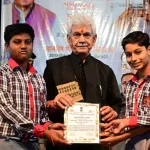In the past nine years, the Modi Government has achieved a remarkable transformation in the Power Sector. The days of constant load shedding and power deficits are now history. Before 2014-15, the deficit in power supply was at a staggering 4.5%. However, since the government took office in 2014, an impressive 185GW of generation capacity has been added, turning the country from power deficit to power surplus. Today, the total installed capacity stands at 417GW, nearly double the peak demand of 222 GW. As a result, India is now exporting power to neighboring countries.
Significant progress has also been made in the transmission sector. Since 2013, an extensive network of transmission lines spanning nearly two lakh circuit kilometers has been established, connecting the entire country into one integrated grid operating at a single frequency. These transmission lines utilize cutting-edge technologies such as 800 KV HVDC and traverse some of the most challenging terrains, including the Srinagar Leh line at heights of 15000/16000 ft above sea level. The ability to transfer 112 GW of power from one corner of the country to another, as against just 36 GW in 2014, has transformed India into a unified power market, allowing distribution companies to purchase power from any generating company across the country at the most competitive rates. This has resulted in lower electricity tariffs for consumers.
Access to electricity has been a major focus of the government’s efforts. Before our government came to power, more than 18,000 villages and numerous hamlets were without electricity, even after 67 years of Independence. In August 2015, Prime Minister Modi announced the target of electrifying every village within 1000 days. Despite facing logistical challenges in hilly regions and desert areas, the government achieved this target in just 987 days – 13 days ahead of the schedule. This achievement was recognized by the International Energy Agency as the most significant news in the energy sector in 2018.
Building upon this success, the government then aimed to connect every household with electricity. Remarkably, this goal was achieved within 18 months, with a total of 2.86 crore homes being connected. This rapid expansion of access to electricity is unprecedented in the history of the energy sector, earning recognition from the International Energy Agency. The policy of the Modi Government is to ensure that no one is left behind.
To strengthen the distribution systems, the government implemented comprehensive schemes across all states with a sanctioned cost of over Rs. Two lakh crores. This included the addition of new substations, upgrades to existing ones, the installation of transformers, and the construction and replacement of thousands of kilometers of LT and HT lines. These efforts have significantly improved power availability in rural areas, increasing the average availability from 12 hours in 2015 to 22.5 hours today, while urban areas now enjoy an average of 23.5 hours of power supply. As a result, the market for DG sets is now dead!
The government has also demonstrated its commitment to the environment through its focus on renewable energy. In 2015, Prime Minister Modi announced the target of installing 175 GW of renewable energy capacity by 2022. Presently, India has established 172 GW of renewable energy capacity, with an additional 84 GW under various stages of implementation. This growth has positioned India as the fastest-growing country in terms of renewable energy capacity, attracting investments from major funds worldwide. Furthermore, India has achieved its commitment of 40% power generation capacity from renewables by 2030, nine years ahead of schedule. Currently, non-fossil fuel sources account for 43% of the installed power generation capacity, totaling 180 GW.
The government has also been successful in reducing emissions intensity. By achieving the target of reducing emissions intensity by 33%-35% compared to 2005 levels, India has positioned itself as the only G-20 nation and major economy aligned with a sub-2-degree rise in global temperature. Various programs such as Ujala (LED distribution), Perform, Achieve and Trade (PAT), the Star Rating program for appliances and Energy Saving Certificates have contributed to reduction of 159 million tonnes per annum in CO2 emissions. Building Codes aimed at energy conservation in commercial and residential buildings are another major step in this direction. We have now pledged to reduce our CO2 emissions by 1 billion tonnes and energy intensity of our economy by 45 percent by 2030 against 2005 levels. We shall also achieve these targets before 2030.
Comprehensive reforms have been implemented across the entire power sector. Measures have been taken to improve efficiency and financial discipline in distribution companies (DISCOMs), such as linking financing to the reduction of AT&C losses, implementing energy accounting and audits, and ensuring timely payment of subsidies by state governments. As a result, AT&C losses of DISCOMs have come down from 22% in the FY 21 to 16.44% in the FY 22. The legacy dues of DISCOMs to Gencos have reduced to nearly half – from Rs. 1.4 lakh crores to Rs. 80 thousand crores. The current payments for electricity drawn by DISCOMs are up-to-date.
By allowing flexibility for the most efficient generating stations to be scheduled first, we have reduced the cost of power for consumers. The electricity market has also expanded through introduction of the Real-Time Market; and by putting in place separate Term Ahead and Day-Ahead Market for Renewable Energy.
In effort towards energy transition, we have permitted bundling of Renewable Energy with Thermal Energy and Bio-Mass co-firings in thermal power plants. Any consumer with a connected load of 100 kW or above can now get Renewable Energy from such generating plants. Government is supporting Solar PV cell manufacturing through PLI and Battery Energy Storage System with Viability Gap Funding.
The Hydro Sector – which was in doldrums, has been re-energized with almost 15 GW under construction. Rules and guidelines for setting up Charging Infrastructure for EVs have been simplified and charging from domestic connections, has been made possible. The dispute resolution mechanism, now decides dispute within a month.
In summary, the Modi Government has led a remarkable transformation in the power sector. With a focus on expanding generation capacity, enhancing transmission networks, increasing access to electricity, promoting renewable energy, and implementing comprehensive reforms, India has achieved unprecedented milestones. The government’s commitment to the environment, energy efficiency, and sustainable development has positioned India as a global leader in the energy transition. With increased targets for renewable energy and further reductions in emissions, the Modi Government continues to power the future of India’s power sector.
(The Author is Union Power Minister, Govt of India)





